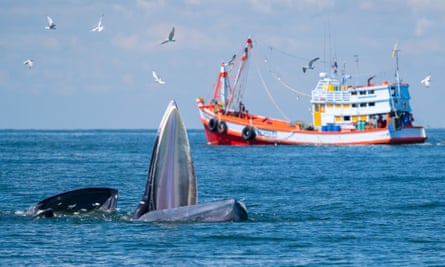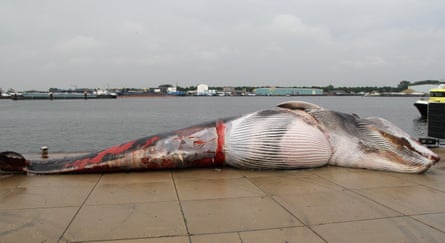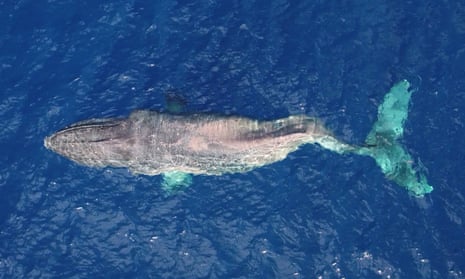Janie Wray could tell there was something horribly wrong from the way her colleague gasped. They were on a research station off the coast of British Columbia and Wray’s colleague was watching live drone footage through a pair of goggles. “She just went, oh my God,” says Wray.
She had spotted a humpback whale on its migration south, swimming without the use of its tail. Wray and her colleagues at BC Whales crowded around a computer screen to watch the footage. “Immediately, we all knew that we had a whale that most likely had a broken back,” she says. It was almost certainly the result of a ship strike. Later, they discovered it was a whale they knew: Moon.
A collision with a vessel is one of the main threats to whales and if the whale does not die on impact, it is usually only a question of time. In Moon’s case, Wray knows she made the 3,000 mile migration to Hawaii. “We’re actually hoping that she has passed,” says Wray. She has not been seen since December.
With potentially thousands of whales hit every year, and with the number of ships rapidly increasing across the globe, the problem is only getting worse. But as the recent UN high seas treaty shows, there is increasing political will to protect the world’s oceans and their inhabitants. The question is whether it is even possible to save the whales from dying at the bows of ships. New technology suggests yes – but it’s going to take all hands on deck.
Commercial whaling, which killed 3m whales in the 20th century, was banned in most countries in the mid-1980s. But since then, another threat has continued to grow: ocean traffic. Worldwide ship numbers quadrupled between 1992 and 2012 and while it is driven by increased traffic in Asia it is happening everywhere.
For example, along western Europe, the density of ships and boats increased by more than a third in the mid-2010s, according to a recent paper. “Cargo boats, fishing boats, ferries… Vessel traffic is increasing across the whole spectrum,” says Sarah Marley from Scotland’s Rural College, who led the work. That’s true even within protected areas, for example around the Inner Hebrides, which is home to a third of Scotland’s harbour porpoises and where traffic rose by over 400%.
Consequently, the risk of fatal ship strikes has ballooned. Global data is limited, but if we extrapolate from regional studies, Sean Brillant from the Canadian Wildlife Federation says the annual number is “shockingly large – thousands to tens of thousands”. And according to the International Whaling Commision (IWC), strikes are increasing. Its analysis suggests vulnerable species are at risk across the globe: from blue whales in Chile to sperm whales in the Mediterranean.
So far, there have been two main solutions. One has been to reroute shipping lanes away from whale habitat, which, despite its effectiveness, rarely happens. The other is speed limits, but they vary in scale and enforcement. For example, while mandatory to follow in regions on the American east coast to protect the last few North Atlantic right whales, they are only recommended on the west coast.
And that can be felt in the Santa Barbara channel in California. It houses both a busy shipping lane into Los Angeles as well as endangered blue, fin and humpback whales. “[It] just happens to be one of these global hotspots of whale and ship overlap,” says Callie Steffen from the University of California Santa Barbara. 2018, 2019 and 2021 were all record years for ship strikes there.

In an effort to increase compliance with the speed guidance, Steffen and her colleagues started the Whale Safe project in 2020, based on the idea that if crews were more aware of whales, they might be more mindful. Consequently, they track the whales – combining satellite information, sightings from whale-watchers and data from acoustics buoys that listen for whale calls underwater – to compute a “whale presence rating”.
This is sent to incoming ships to remind captains to slow down and it appears to be working; in 2019, 46% of ships followed the guidelines and by 2022 it was 61.5%. “We really want to make sure that these numbers are going the right way and hopefully faster,” says Steffen. But even if all ships did comply, not everyone is convinced it is going to be enough.
In most places that have whale-protective speed restrictions or guidelines, the limit is 10 knots or 18.5 km/h. The figure is based on a number of studies that compared fatal strikes to strikes that, allegedly, didn’t kill the whale. The results showed that the probability of a whale dying of a strike is around 50% at 10 knots, compared to the near-certainty of death at double the speed.
But as Moon illustrates, not all struck whales die immediately and recent research suggests that even if 95% of large ships in the Santa Barbara channel slowed to 10 knots, the reduction in whale mortality would be 30% at most. In fact, if you look at the raw physics of a collision, like Brillant and his colleagues did in 2020, it becomes clear that there is no speed that can really be considered safe.
They found that the risk of killing a whale at 10 knots is still around 80% for large ships, while for smaller vessels such as fishing boats, the risk remains above 50%. “It means two things,” says Brillant. “One is that we can’t rely on speed restrictions to solve this problem… And number two is that we do need to pay attention to the small vessels.”
To Brillant, the clear implication is that we need full exclusion zones where no boats are allowed, but such areas cannot be implemented everywhere. He mentions the southern gulf of Saint Lawrence, where North Atlantic right whales swim between two feeding grounds. “One of the busiest shipping lanes in the world, coming into the Great Lakes, goes east-west, and the whales are going north-south. There’s no solution to that,” he says.
In those situations, he pins his hopes on the imperfect speed restrictions. But one physicist-turned-marine researcher thinks he has found a way to make them more effective. Instead of giving captains a general whale rating, he has developed a system that pings them when they are heading for a strike, just in time to swerve.
Daniel Zitterbart’s whale-alert system has been in the pipeline for a decade. Now, he says, he and his colleagues at the Woods Hole Oceanographic Institution in Massachusetts are nearing the finish line.
In their latest paper, they model the chances of ships spotting whales in time to avoid them when using their now commercialised system: software hooked up to thermal cameras that detect the hot air exhaled through whale blowholes at the surface. For smaller, manoeuvrable ships that need less time to react, the probability “is already 99%”, says Zitterbart.

Unwieldy, high-speed container ships, on the other hand, need much more warning time, so the cameras have to detect whales when they are further away. Because blows last only a few seconds, they are tricky to reliably detect at a distance. “Right now [the reliable detection range] is between two and three kilometres and actually we need it to go to about four,” says Zitterbart.
He says this is achievable within two to three years, at which point he says the chance of a fast container ship spotting a whale in time will be around 80%. “Changing your course by 0.1 degree to the right side if you know the whale is swimming to the left… If you have kilometres, your ship might just pull that off.” But slowing the ship to 10 knots drastically improves the odds too, meaning that speed limits and detection tech together could already be a winning combination.
Other, commercial detection systems are also starting to pop up: Orca AI, a company that makes smart machine-vision navigation systems, recently added a whale-detection function. Its co-founder Dor Raviv says it was a client sailing in speed-restricted Canadian waters that first approached him about it. “We truly believe that we have all the infrastructure in place,” he says now.
Some pitfalls remain. For instance, OrcaAI’s algorithms mainly detect the whale’s tail, but Zitterbart says whales only show their tails when diving, which usually takes them out of danger. There is also disagreement on whether detection tech should complement speed limits – Zitterbart’s work shows the two enhance each other, but some of Raviv’s clients might use the cameras as an excuse not to slow down.
Brillant is generally sceptical of early detection. He can’t see how any warning could make an enormous ship avoid a moving whale. “I just don’t believe they should gain much credit as preventative measures.”
And even if the tech does live up to its promise, companies need an incentive to invest – to start, thermal cameras cost between $30,000-$250,000. Zitterbart expects the rise of autonomous vessels will bring about that incentive, because “you don’t want your fancy autonomous vessel to run into an animal”. But the transition to no-crew ships will be slow, so the real challenge will be to get the tech on board vessels already at sea and he sees only one path to that. “If there is no regulator forcing it, people will just not do it.”
Achieving regulation, whether for mandatory speed limits, exclusion zones or detection kit, is easier said than done. The relatively straightforward policy of banning commercial whaling, for example, took decades. One thing that will help, though, is better data to reveal the true scale of the problem and what solutions have the most impact, but that depends on captains consistently reporting when they have hit a whale.
Wray hopes that Moon’s story will serve as encouragement to do just that and that talking about Moon will spur on legislators to take at least local action, such as creating slow-down zones along the coast of British Columbia in her memory. “I think if everybody just thinks about Moon, so that if they see a [whale’s] blow, they actually slow down,” she says. “That would be really wonderful.”
Why Moon made the seemingly impossible 3,000-mile journey to a breeding ground with a broken back is impossible to know, but Wray can’t stop wondering if she was pregnant. Whether she was or not, the mere possibility is a reminder that every fatal ship strike means both the loss of a whale and a setback to a recovering species.

Comments (…)
Sign in or create your Guardian account to join the discussion